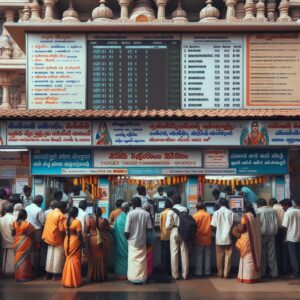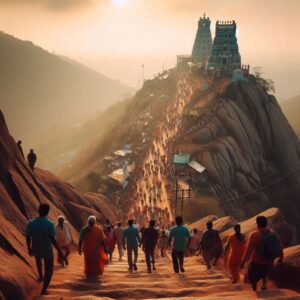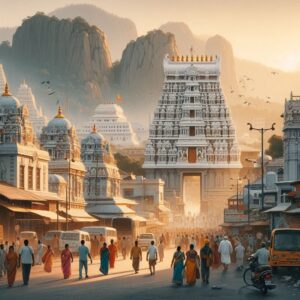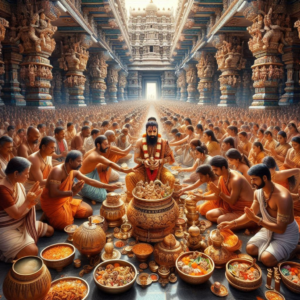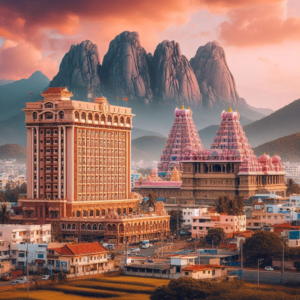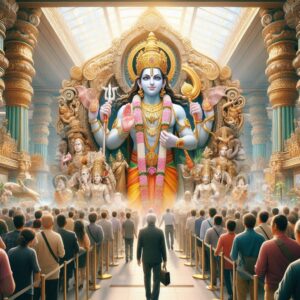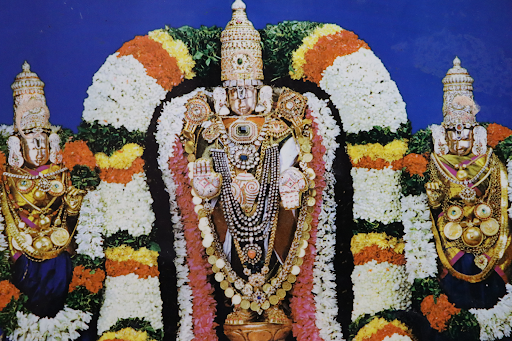
When it comes to religious significance and opulence, the Tirupati Temple in India stands out as a shining beacon. This revered temple, nestled in the southern part of the country, holds a unique position as the most sacred and wealthiest temple globally. Pilgrims from far and wide flock to this divine destination, making it a pivotal pilgrimage center in South India.
Table of Contents:
- Introduction
- A Spiritual Journey to Tirupati
- A Hilltop Sanctuary
- The Richest of Them All
- Architectural Marvels of Tirupati
- Dravidian Grandeur
- Three Enclosures
- A Divine Fusion
- Spiritual Routines at Tirupati
- Awakening the Lord
- Putting the Lord to Rest
- Devotee Offerings
- Celebrations and Festivals
- The Grand Brahmotsavam
- Journey to Tirupati
- Air Travel
- Rail Connections
- Roadways
- Conclusion
A Spiritual Journey to Tirupati
A Hilltop Sanctuary
Tirupati Temple is perched atop a hill in Tirumala, known as “Seshachalam and Venkatachalam,” standing tall at 853 meters above sea level. The pilgrimage to this sacred site is not for the faint-hearted, as devotees must climb the hill to reach the temple’s gates. Legend has it that only those with unwavering faith in God can complete this arduous ascent unassisted.
The Richest of Them All
Tirupati Temple isn’t just a spiritual hub; it’s also the richest temple globally. It’s said that devotees, overwhelmed by their devotion, offer bags of diamonds at the feet of Sri Venkateswara, the temple’s presiding deity. Pilgrims travel from distant corners of the world to pay their respects here, drawn by the allure of divine blessings and a vibrant spiritual atmosphere.
Architectural Marvels of Tirupati
Dravidian Grandeur
The temple boasts a resplendent Dravidian architectural style, a testament to India’s rich cultural heritage. Its most striking feature is the towering “Gopuram.” Over the “sanctum sanctorum” rests the Vimana, known as “Ananda Nilayam,” gleaming under a golden plate.
Three Enclosures
Tirupati Temple encompasses three “Prakarams” or enclosures. Among these, the most significant is the “Dhvajastambha,” the banner post that signifies the temple’s prominence.
A Divine Fusion
The idol worshipped at Tirupati Temple represents both Lord Vishnu and Lord Shiva. In Hindu mythology, Lord Vishnu is the preserver of the universe, while Lord Shiva is the destroyer. This union of two mighty deities makes the temple even more spiritually potent.
Spiritual Routines at Tirupati
Awakening the Lord
A typical day at the temple commences with the “Suprabhatam,” signifying the awakening of the Lord. This sacred ritual takes place at the crack of dawn, setting a reverent tone for the day.
Putting the Lord to Rest
Conversely, the day concludes at Tirupati Temple with the “Ekanta Seva,” which involves putting the Lord to rest, typically around 1 o’clock in the morning. This tranquil ritual marks the end of a spiritually charged day.
Devotee Offerings
Devotees express their devotion through daily, weekly, and periodic prayers, while priests continuously chant sacred hymns. These prayers take the form of “Sevas” and “Utsavams,” offerings of service and celebration to the Lord. Devotees also contribute by donating small sums in their names, which are collected in “Hundis.” These donations serve as the primary source of income for the temple.
Celebrations and Festivals
The Grand Brahmotsavam
One of the most significant events at Tirupati Temple is the annual “Brahmotsavam” festival. Spanning nine days in September, this festival radiates enthusiasm and spiritual fervor. Highlights include the “Garudostavam” and “Rathotsavam” festivals on the fifth and sixth days, which draw tourists and devotees alike from all corners of the country.
Journey to Tirupati
Roadways with Viswambara Travels
If you prefer traveling by road, you can experience the utmost convenience and comfort by choosing Viswambara Travels. We offer cab services and bus options from various cities, including Hyderabad (617 km away), Bangalore (248 km), Chennai (151 km), Vijayawada (380 km), and Lepakshi (379 km). Travel with us to make your journey to Tirupati Temple truly enjoyable and stress-free.
Rail Connections
Tirupati is also well-connected by rail. Tirupati Station serves as the nearest railway station, with train services available from Hubli, Hyderabad, Chennai, Kolhapur, Mumbai, Puri, Tiruchirappalli, Vijayawada, and Varanasi.
Air Travel
For those traveling from afar, the nearest airports are in Hyderabad, Chennai, and Bangalore. Renigunta Airport, located 15 km from the temple, offers easy access. From there, one can hire a cab, take a bus, or opt for an auto-rickshaw to reach the temple.
Conclusion:
In conclusion, the Tirupati Temple stands as a symbol of spirituality, cultural richness, and devotion. Its fame as the most sacred and wealthiest temple in the world is well-deserved, given its unique blend of architectural wonders, deep-rooted traditions, and the grandeur of the annual Brahmotsavam festival. For those planning a pilgrimage to this divine destination, choosing Viswambara Travels ensures a hassle-free and memorable journey to experience the magic of Tirupati’s spirituality and beauty.
FAQs:
Q1: Why is Tirupati Temple so famous?
A: Tirupati Temple’s fame arises from its sacredness, richness, and spiritual significance, making it the most revered temple globally.
Q2: How can I reach Tirupati Temple?
A: You can reach Tirupati by air (via airports in Hyderabad, Chennai, or Bangalore), train (Tirupati Station), or road (from major cities like Hyderabad, Bangalore, Chennai, Vijayawada, and Lepakshi).
Q3: What is the significance of the Brahmotsavam festival?
A: The annual Brahmotsavam festival at Tirupati Temple spans nine days in September and is celebrated with great enthusiasm. It includes special events like the Garudostavam and Rathotsavam, attracting devotees and tourists from all over India.
Q4: What is the architecture of Tirupati Temple like?
A: Tirupati Temple showcases the Dravidian architectural style, featuring a magnificent Gopuram and a Vimana covered in gold. It has three enclosures, with the Dhvajastambha as a prominent feature.

